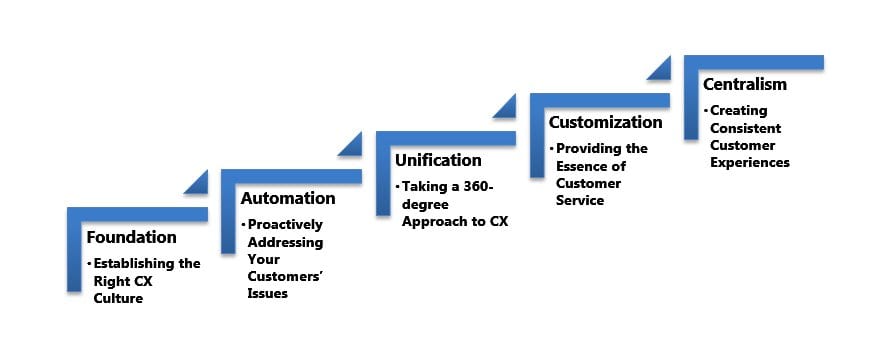
Today’s digital landscape has ushered in a new age in customer service. As companies use digital interfaces to engage with customers and build relationships, customer interactions are spanning across an ever-expanding array of touchpoints, with customers often using various channels in the quest to get the service that they need when they need it.
Indeed, customer service is the new battleground. While service represents challenges, it’s also full of opportunities for companies that have a strategic plan. Before you redirect your investments to customer experience innovation, here are five practices to keep in mind:

Foundation: Establishing the Right CX Culture
At the heart of any digital strategic planning to improve the customer service experience is to first foster a company culture that nurtures the hearts and minds of those responsible for that service. Hiring the right people behind the technology, starting with cross-functional team leadership and establishing a people-oriented attitude from the beginning is the best way to ensure that such an attitude is transmitted to your customers. In addition, companies must emphasize training the necessary skills to transform visionary thinking into actual practice. These skills certainly extend to the CX arena where some companies today are even training their digital CX teams in soft skills like storytelling and facilitation to reach the heart of the customer himself.
Automation: Proactively Addressing Your Customers’ Issues
Traditionally, customer service is thought of as a mostly reactive function, with the goal being to pacify or inform customers only after they have initiated some kind of complaint or question. However, reaching out to contact to a customer before a problem arises can make all the difference in operational effectiveness. Today, the analytics provided through marketing automation and customer engagement management can reveal where processes are failing or succeeding in the use of a service or product. This information can be used to maximize engagement continuously in real-time, according to the customers’ changing needs, and enable companies to proactively address the customer issues before they become a major problem.
Unification: Taking a 360-degree Approach to CX
Today, customers engage with their brands through more channels than ever before. At the same time, many companies are struggling to keep pace with the growing complexity of digital experiences, as well as consumer expectations to seamlessly move between these various touchpoints. In fact, Aberdeen Group Inc. claims that companies with the strongest “Omni-channel” customer engagement strategies retain an average of 89% of their customers, as compared to 33% for companies with weak Omni-channel strategies. However, while customers may accept different service levels from different channels, they expect the communication to remain consistent, and that creates a real challenge. Indeed, this multi-channel customer experience necessitates taking a “360-degree view” of each person and is a vital strategy for connecting that person’s multi-channel experience with your particular brand.
Customization: Providing the Essence of Customer Service
Despite the increase in self-service applications, many people still seek personal attention in their customer service. They want to feel like they are dealing with other real people who are invested in solving their issue, not impersonal brands. The pursuit of digital innovation needs to contain at its core awareness of how it can be applied to optimize customer service through the ability to relate to the unique wants and needs of each individual customer. Instead of focusing on what the technology can do and then formulating the customer service strategy around it, companies need instead to define the optimal digital customer service experience, including maintaining its personalization, and then identify what tools and software are needed to make it happen.
Centralism: Creating Consistent Customer Experiences
As companies offer digital experiences on such a wide variety of engagement platforms, the challenge of effectively managing all those touchpoints is becoming increasingly difficult, and costly. Especially for large scale companies, providing a consistent customer experience across a variety of digital channels is essential, and without an effective means of quality control, errors are bound to happen. That’s why, for example, many companies are turning to SaaS Digital Quality Management (DQM) platforms that can integrate with their current web content management system (WCM), and which provides centralized control of content and messaging across their entire digital landscape based on pre-defined criteria. Centralized management across all digital touchpoints ensures a consistent customer experience and brand integrity.
Customers these days have more power and choice than ever before, so keep these practices in mind to leverage your customer service and drive brand loyalty. That choice is up to you!
[About the author] Dylon Mills is the Director of Marketing Content Strategy & Development at Uniphore. As such, Dylon’s main responsibilities are to strategize, create and deliver content for Uniphore’s product portfolio that aligns with the global Go-To-Market strategy, corporate positioning, and marketing campaigns. Dylon’s prior work experience includes Product Management at one of the top Fortune 500 Technology companies, Symantec Corporation. Outside of work, Dylon enjoys problem-solving and any project that includes building/tinkering with tools. Dylon holds a BS Consumer Economics from the University of Georgia.
Dylon Mills is the Director of Marketing Content Strategy & Development at Uniphore. As such, Dylon’s main responsibilities are to strategize, create and deliver content for Uniphore’s product portfolio that aligns with the global Go-To-Market strategy, corporate positioning, and marketing campaigns. Dylon’s prior work experience includes Product Management at one of the top Fortune 500 Technology companies, Symantec Corporation. Outside of work, Dylon enjoys problem-solving and any project that includes building/tinkering with tools. Dylon holds a BS Consumer Economics from the University of Georgia.
)